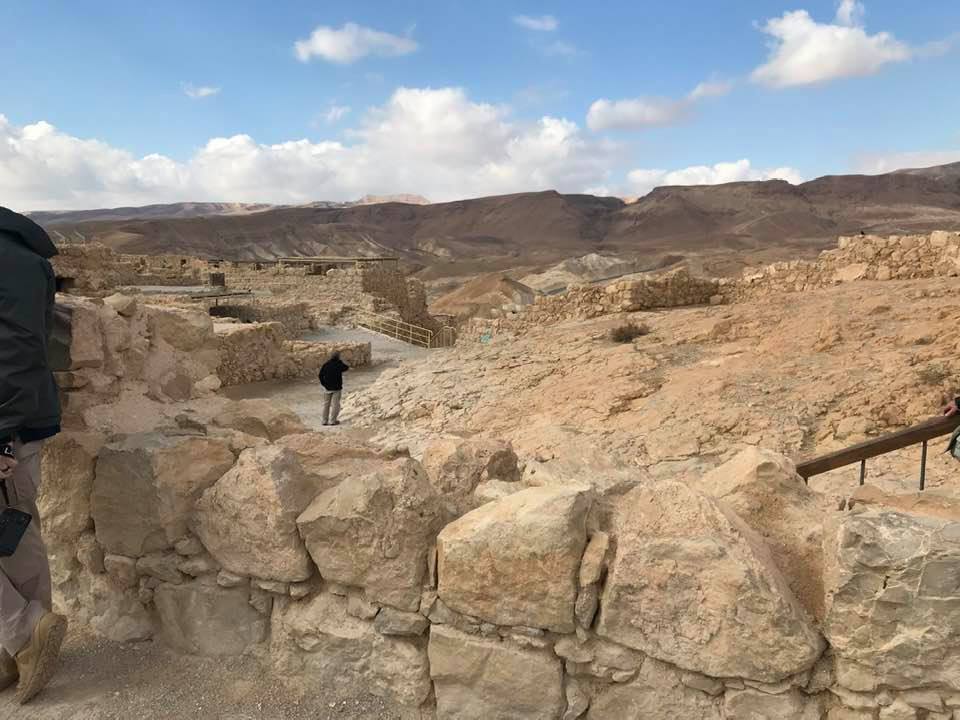Geography
The cliff of Masada is, geologically speaking, a horst. As the plateau abruptly ends in cliffs steeply falling about 400 m (1,300 ft) to the east and about 90 m (300 ft) to the west, the natural approaches to the fortress are very difficult to navigate. The top of the mesa-like plateau is flat and rhomboid-shaped, about 550 m (1,800 ft) by 270 m (890 ft). Herod built a 4 m (13 ft) high casemate wall around the plateau totalling 1,300 m (4,300 ft) in length, reinforced by many towers. The fortress contained storehouses, barracks, an armory, a palace, and cisterns that were refilled by rainwater. Three narrow, winding paths led from below up to fortified gates.
History
Almost all historical information about Masada comes from the first-century Jewish Roman historian Josephus.
Hasmonean fortress
Josephus writes that the site was first fortified by Hasmonean ruler Alexander Jannaeus in the first century BCE. However, so far no Hasmonean-period building remains could be identified during archaeological excavations.
Josephus further writes that Herod the Great captured it in the power struggle that followed the death of his father Antipater. It survived the siege of the last Hasmonean king Antigonus II Mattathias, who ruled with Parthian support.
Herodian palace-fortress
According to Josephus, between 37 and 31 BCE, Herod the Great built a large fortress on the plateau as a refuge for himself in the event of a revolt, and erected there two palaces.
First Jewish-Roman War
In 66 CE, a group of Jewish rebels, the Sicarii, overcame the Roman garrison of Masada with the aid of a ruse. After the destruction of the Second Temple in 70 CE, additional members of the Sicarii fled Jerusalem and settled on the mountaintop after slaughtering the Roman garrison. According to Josephus, the Sicarii were an extremist Jewish splinter group antagonistic to a larger grouping of Jews referred to as the Zealots, who carried the main burden of the rebellion. Josephus said that the Sicarii raided nearby Jewish villages including Ein Gedi, where they massacred 700 women and children.
In 73 CE, the Roman governor of Iudaea, Lucius Flavius Silva, headed the Roman legion X Fretensis and laid siege to Masada. The Roman legion surrounded Masada, built a circumvallation wall and then a siege ramp against the western face of the plateau. According to Dan Gill, geological investigations in the early 1990s confirmed earlier observations that the 114 m (375 ft) high assault ramp consisted mostly of a natural spur of bedrock. The ramp was complete in the spring of 73, after probably two to three months of siege, allowing the Romans to finally breach the wall of the fortress with a battering ram on April 16. The Romans employed the X Legion and a number of auxiliary units and Jewish prisoners of war, totaling some 15,000 (of whom an estimated 8,000 to 9,000 were fighting men), in crushing Jewish resistance at Masada. A giant siege tower with a battering ram was constructed and moved laboriously up the completed ramp. According to Josephus, when Roman troops entered the fortress, they discovered that its defendants had set all the buildings but the food storerooms ablaze and committed mass suicide or killed each other, 960 men, women, and children in total. Josephus wrote of two stirring speeches that the Sicari leader had made to convince his men to kill themselves. Only two women and five children were found alive.
Josephus presumably based his narration upon the field commentaries of the Roman commanders that were accessible to him.
Significant discrepancies exist between archaeological findings and Josephus’ writings. Josephus mentions only one of the two palaces that have been excavated, refers only to one fire, while many buildings show fire damage, and claims that 960 people were killed, while the remains of only 28 bodies at the very most have been found.
The year of the siege of Masada may have been 73 or 74 CE.
Byzantine monastery of Marda
Masada was last occupied during the Byzantine period, when a small church was established at the site. The church was part of a monastic settlement identified with the monastery of Marda known from hagiographical literature. This identification is generally accepted by researchers. The Aramaic common noun marda, “fortress”, corresponds in meaning to the Greek name of another desert monastery of the time, Kastellion, and is used to describe that site in the vita (biography) of St Sabbas, but it is only used as a proper name for the monastery at Masada, as can be seen from the vita of St Euthymius.

